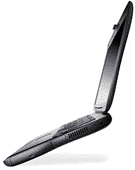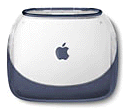It's a frustrating reality: portables make up only a small fraction
of Apple's total computer sales. Based on Apple's data, PowerBooks were
14.5% of all Macs sold in fiscal 1997, 15.5% in 1998, and 10.2% in
1999.
Does this help explain the dearth of iBook and PowerBook sites on
the Web? It hasn't been easy going supporting such a small market when
over 85% of the Macs in use are desktops.
Still, there are a handful of good PowerBook and iBook sites out
there just waiting for the inevitable rise of portable computing.
It's already started. Thanks to the iBook, Apple sold 235,000 iBooks
and roughly 80-85,000 PowerBooks out of a total of 1,377,000 computers
during the last three months of 1999. That brings portable sales to 23%
of Apple's total during the first quarter of fiscal 2000 - very
impressive.
If anything, the new 400
and 500 MHz Pismo PowerBooks and the improved
iBooks should further grow the Mac portable market. Although some of
what happened last quarter was pent-up demand for the iBook (which
didn't ship until the very end of September), I think it's realistic
that 25% of all Macs sold this year will be portables - even if Apple
doesn't add new models such as a thin-and-light PowerBook or one with a
huge screen.
And that figure will only increase.
Changes
Desktop computers have had their day in the sun. For almost
25 years they were the dominant species because of price,
performance, and features. But unless you need the Velocity Engine of
the G4, a huge monitor, or a special add-in PCI card, the new Pismo
PowerBook may be all the computer you need.
 Best of all, you can now buy a PowerBook without
paying a huge premium over the price of a desktop system. For instance,
we've settled on the Power Mac G4/450 as our
base computer at work. That's a $2,500 computer before we add a 19"
monitor for about $450.
Best of all, you can now buy a PowerBook without
paying a huge premium over the price of a desktop system. For instance,
we've settled on the Power Mac G4/450 as our
base computer at work. That's a $2,500 computer before we add a 19"
monitor for about $450.
The 400 MHz PowerBook offers about 85% of the power for $2,500 - or
$2,700 if we bump memory to 128 MB. Throw in $75 for a case, and it's
still less expensive than the larger, more versatile Power Mac.
But the real strength is the portability. At this point, unless a
user needs a huge screen or absolutely has no need to ever take a
computer into the field, I recommend my employer buy a PowerBook
instead of a Power Mac.
Sure, we could save money by using the slower Power Mac G4/400, but
the new computers always go to our design department first, then their
Macs trickle down to other parts of the business. Designers don't need the
absolute fastest machines Apple makes, but neither do we want to set
them up with the slowest. We've pretty much settled on the mid-speed
Power Mac at any given time.
What About the iBook
Things are a bit different with the iBook/iMac comparison, but much
closer now that Apple has increased memory and drive size on the
iBook.
We do use some iMacs at work, especially for users who won't ever
need a bigger display. These are generally people doing a lot of data
entry or word processing, people for whom portability is not an
issue.
But we also have an iBook, which does everything
the old iMac did, but in a portable package. Unfortunately, the
economics aren't quite the same here. The mid-speed iMac is the $1,300
iMac DV running a
400 MHz processor.
 The iBook can't compete on
cost - it retails for $300 more and runs at only 75% of the iMac's
speed. And comparing the iBook SE to the iMac DV SE
doesn't help much, although you do achieve 90% of the iMac's speed in
that comparison.
The iBook can't compete on
cost - it retails for $300 more and runs at only 75% of the iMac's
speed. And comparing the iBook SE to the iMac DV SE
doesn't help much, although you do achieve 90% of the iMac's speed in
that comparison.
No, the iBook has to stand on its portability, something it does
quite well. Again, unless a user needs something bigger than the
iBook's 800 x 600 screen, it's a great portable choice and an excellent
value (a point I hope to drive home more completely next week by
comparing the iBook to similarly priced Windows machines).
The Future
Everyone agrees that in the near future flat panel displays will
replace traditional computer monitors. Although only a niche market
now, as that market grows and prices drop, they will become a larger
and larger segment of the display market.
My guess is that we'll see a flat panel iMac in 2002. (Update:
The flat panel iMac
G4 was introduced in January 2002.) This will make the
iMac even smaller (mostly thinner) and lighter.
The cost of portables will continue decreasing along with the cost
of the display, which is the most expensive component in a portable
computer. There will still be a small price premium to cover the
battery and AC adapter, but within two or three years portable computers
could make up half the market as prices come closer and closer to those
of desktop systems.
Within five years desktops could become niche products: iMac
terminals for use in libraries, Power Mac servers to deliver files to
your AirPort equipped iBooks and PowerBooks.
And Apple is poised to take full advantage of that. The iBook is
already one of the best portable computing values on the market. The
Pismo PowerBook is the most powerful laptop made. These two models probably
meet the needs of 80% of the Road Warriors out there, although a lot
would prefer something lighter or even larger - if Apple gave them that
choice.
The Pentium III laptops run so hot and draw so much power that the
newest models are designed to drop back to 500 MHz when running on
battery power, so they're only 650 MHz machines when used with the AC adapter or
if you deliberately choose to turn off the power reduction mode.
With the PowerPC processor, we don't have to worry about that. IBM
has the ability to deliver G3/600 processors in short order, and the
next revision of the G4 (expected in May or June) will have a lower
power draw than the current one while breaking the 500 MHz ceiling of
today's G4 design. It is conceivable we'll see a PowerBook G4 later
this year. (Update: The first
PowerBook G4 arrived in January 2001.)
The future will belong to the company with the best portables. Apple
has been a leader in portable innovation since the Mac Portable (built in trackball,
active matrix display, memory-free battery, long battery life) and is
well positioned to build on its experience.

 Best of all, you can now buy a PowerBook without
paying a huge premium over the price of a desktop system. For instance,
we've settled on the
Best of all, you can now buy a PowerBook without
paying a huge premium over the price of a desktop system. For instance,
we've settled on the  The iBook can't compete on
cost - it retails for $300 more and runs at only 75% of the iMac's
speed. And comparing the
The iBook can't compete on
cost - it retails for $300 more and runs at only 75% of the iMac's
speed. And comparing the 
